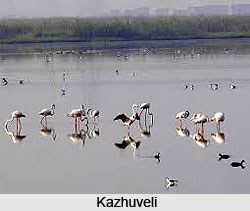 Kazhuveli is located at about 18 kilometres north of Puducherry, which is known as "The French Riviera of the East" (La Cote d`Azur de l`Est). Kazhuveli is the second largest brackish water lake in South India located in Tindivanam taluk of Villupuram district of the state of Tamil Nadu.
Kazhuveli is located at about 18 kilometres north of Puducherry, which is known as "The French Riviera of the East" (La Cote d`Azur de l`Est). Kazhuveli is the second largest brackish water lake in South India located in Tindivanam taluk of Villupuram district of the state of Tamil Nadu.
Kazhuveli tank lies adjacent to the Bay of Bengal along the East Coast Road and includes about 15 villages with a catchment area of 4,722 hectares of land.
Kazhuveli is an old mangrove forest in Tamil Nadu, which has been degraded over period of time. The entire ecosystem of this wetland is completely destroyed and denuded due to human intrusion, chiefly, the establishment of salt pans and over-fishing.
Kazhuveli is one of the prioritized wetlands of Tamil Nadu. It is also one of the 94 identified wetlands under National Wetland Conservation and Management Programme (NWCMP) operationalised by the Government of India in 1985-86 along with Point Calimere and Pallikaranai Marsh in the state of Tamil Nadu.
A total of 196 minor irrigation tanks and ponds drain into the Kazhuveli wetlands of Villupuram district. Out of the total area of 740 square kilometres, 47.22 square kilometres has been declared as protected area under Section 26 of Tamil Nadu Forest Act. In the northern part of Kazhuveli where brackish water could be found, attempts are made to dig up channels in fish-bone design and mangroves species such as Rhizhophora and avicennia have been planted in extents varying from 50 to 100 hectares annually.
In the southernmost portions of Kazhuveli where seasonal water flow is available, the mangrove plantations have been raised in total barren areas with appropriate species through schemes such as Tamil Nadu Afforestation Project and the National Afforestation Project.
The various conservation projects of the mangrove forests near Kazhuveli tasks such as bio-upgradation, eco-development, community development works, protection, monitoring and evaluation are being implemented and seminars and workshops are being conducted since 2007 under the NWCMP. This also happens for fostering tourism in this region which adds the revenue generation in this region. One can find bird species like spotted owlets in this mangrove region of wetland in Villupuram District of Tamil Nadu.



















